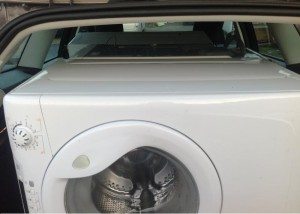How to transport a washing machine - expert advice
 If you move and transport all your things, including household appliances, you will inevitably face the problem of transporting your washing machine. After all, it cannot be transported like ordinary large items. Many questions arise: is it possible to transport an automatic washing machine on its side, is it possible to transport it without packaging, is it possible to transport it without transport bolts, and others. We will try to answer them within the framework of this article.
If you move and transport all your things, including household appliances, you will inevitably face the problem of transporting your washing machine. After all, it cannot be transported like ordinary large items. Many questions arise: is it possible to transport an automatic washing machine on its side, is it possible to transport it without packaging, is it possible to transport it without transport bolts, and others. We will try to answer them within the framework of this article.
How to prepare a washing machine?
Before transportation, it would be correct to place the washing machine in the original packaging, and put polystyrene or foam rubber in the wall, but this is the ideal option. Most often, a washing machine that has worked for more than a year does not have any intact packaging, but also no components or fasteners at all. Therefore, during transportation you will have to improvise. In the process of preparing the washing machine for transportation, first of all, you need to do the following.
- Disconnect the washing machine from electrical and water supplies. At first glance, this seems funny, but there are a huge number of cases when they start moving the machine without disconnecting the hoses or one of the hoses. And often simply by not disconnecting the power cord. What happens after this can be easily guessed.
 Remove any remaining water from the machine. Water stagnates in hoses, pipes, and drain pump and can cause trouble when transporting a household appliance.
Remove any remaining water from the machine. Water stagnates in hoses, pipes, and drain pump and can cause trouble when transporting a household appliance.- Secure the hoses, wires, hatch, so that all this does not dangle and does not interfere with moving the washing machine.
- Cover all sharp corners and protruding sharp parts of the washing machine with tape to avoid injury when carrying the machine.
After this, you need to take measures to fix the washing machine tank. The best fixation option is transportation bolts, which are screwed through holes in the back wall of the washing machine. For more information on installing and removing shipping bolts, see this article.
If the transport bolts have not been preserved, then you need to open the upper wall of the washing machine by unscrewing several bolts, and then put foam rubber, polystyrene foam, clean rags, etc. in the space between the tank and the walls. Then you need to return the upper wall back along with the fasteners.
After you have secured the tank, wrap the body of the washing machine in fabric and tie it with twine. If you carry out all the above steps, you can successfully transport the machine without the original packaging, you just need to be careful.

Transporting the washing machine
Once the washing machine is properly prepared for transport, it can be carried and loaded into the vehicle. Often you have to lower the machine from the top floor of a multi-storey building, which is quite difficult considering the dimensions and weight of this equipment. Experts recommend not turning the washing machine over when carrying it to the car. The only thing that is allowed is some tilt back.
Next, you need to decide how to load the automatic washing machine into the vehicle. There are several options for properly loading a washing machine; the choice of option depends on the characteristics of the car.If it’s a large truck, everything is simpler; if it’s a domestic passenger car, it’s more complicated. You can transport the machine:
- in a natural position - standing;
- on the side wall;
- on the back wall.
The best option for transporting a washing machine, according to experts, is standing, provided the tank is fixed. The machine should be turned sideways in the direction of travel of the car. Moreover, if there are other large items in the back of the truck, you need to place the washing machine so that it is sandwiched between them. In this case, the shock absorbers will remain intact and no pipes or contacts will be damaged.
Important! You cannot transport the washing machine on the lid, that is, upside down. A car can survive transportation with its legs up only if the engine and all moisture are removed from it.
 It would also be nice if you put the “washing machine” on its side when transporting it. In this case, according to some experts, there is no need to even fix the tank of the car. But we, for our part, recommend that even with this transportation option, you either screw in the shipping bolts or secure the tank with foam rubber.
It would also be nice if you put the “washing machine” on its side when transporting it. In this case, according to some experts, there is no need to even fix the tank of the car. But we, for our part, recommend that even with this transportation option, you either screw in the shipping bolts or secure the tank with foam rubber.
When placing the machine on its side, be aware of the powder tray. The fact is that the water accumulated in the cuvette, when turning the car on its side, flows onto the contacts of the control panel and this can lead to damage to the electronics. Therefore, when transporting the machine on its side, remove the powder container and place it separately. Or wipe it dry from the inside with a cloth.
If your washing machine is of any make and model other than Zanussi, then it can be transported completely safely lying on the back wall. In Zanussi washing machines, there is a fill valve in close proximity to the counterweights.If you put the machine on the back wall, the counterweight rests against the filler valve and breaks it.
Important! The washing machine must not be transported on the front wall. If you place the washing machine on the front wall, the hatch fastenings will break and the cuff will tear.
What happens if you violate the rules of preparation and transportation?
Violation of the rules for preparing and transporting an automatic washing machine can lead to the most unfavorable consequences. Just one bad trip with your washing machine can send it straight to the landfill - no joke! Here are some common problems that may arise.
- The integrity of the power cord is damaged.
- The plastic parts of the washing machine body break.
- The cuff breaks and the hatch fastenings break.
- The tank shock absorbers are failing.
- Hoses and pipes are torn.
- Electrical wiring and contacts get wet and short out.
- The control panel toggle switch breaks off.
- The drain pump breaks.
- The unsecured powder cuvette breaks off.
To summarize, we note that even an experienced loader does not always know how to transport a washing machine correctly. Before transportation, the washing machine must be prepared and then properly placed in the vehicle. Otherwise, there is a chance that after handicraft transportation, this item of household appliance will not work.
Interesting:
1 reader comment
Add a comment Cancel reply
Categories
Washing machine repair


For buyers

For users

Dishwasher

















How to transport with top loading?